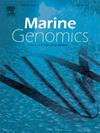De novo assembly and annotation of the pantranscriptome of Astyanax lacustris on the liver and pituitary-gonadal axis
IF 1.5
4区 生物学
Q4 GENETICS & HEREDITY
引用次数: 0
Abstract
Astyanax lacustris is a model of laboratory native fish species. Reproductive studies of this species have already been performed. Nevertheless, there is a relative shortcoming of gene sequence information available in public databases, which hinder their use in more comprehensive investigations that employ sensitivity molecular biology techniques to assess gene expression profile for biomarker identification. In this data article, we report the first de novo transcriptome assembly of A. lacustris testicles, ovaries and male / female pituitary gland improving gene sequence data available for this fish species and transcriptome of male liver. Illumina sequencing generated 808,023,356 raw reads, filtered in 752,739,866 high-quality reads. Initially, a de novo assembly was filtered to include protein coding elements only in each tissue sample, which were merged in a final pantranscriptome (PAN) containing 109,232 contigs. The PAN was functionally annotated against a custom Actinopterygii proteins dataset and EggNOG terms with the aid of EnTAP, retrieving homology queries for about 90 % of all transcripts. Therefore, in this study we provide a PAN and a custom blast tool that can help discovery genomic information on metabolism pathways and their related genes in A. lacustris, enabling future research and molecular studies using this fish species as a model.
湖astanax lastris肝脏和垂体性腺轴全转录组的从头组装和注释
Astyanax lacustris 是实验室原生鱼类物种的模型。该物种的繁殖研究已经开展。然而,公共数据库中可获得的基因序列信息相对不足,这阻碍了它们在更全面的研究中的应用,这些研究采用灵敏的分子生物学技术来评估基因表达谱,以鉴定生物标记物。在这篇数据文章中,我们首次报告了从头组装的 A. lacustris 睾丸、卵巢和雄性/雌性垂体的转录组,改进了该鱼种现有的基因序列数据和雄性肝脏的转录组。Illumina 测序产生了 808,023,356 个原始读数,筛选出 752,739,866 个高质量读数。最初,对从头组装进行了过滤,只包括每个组织样本中的蛋白质编码元素,然后合并成最终的泛转录组(PAN),其中包含 109,232 个等位基因。在 EnTAP 的帮助下,根据定制的翼手目蛋白质数据集和 EggNOG 术语对泛转录组进行了功能注释,检索到所有转录本中约 90% 的同源性查询。因此,在这项研究中,我们提供了一个 PAN 和一个定制的 blast 工具,可帮助发现 A. lacustris 新陈代谢通路及其相关基因的基因组信息,从而有助于未来以该鱼种为模型开展研究和分子研究。
本文章由计算机程序翻译,如有差异,请以英文原文为准。
求助全文
约1分钟内获得全文
求助全文
来源期刊

Marine genomics
生物-遗传学
CiteScore
3.60
自引率
5.30%
发文量
50
审稿时长
29 days
期刊介绍:
The journal publishes papers on all functional and evolutionary aspects of genes, chromatin, chromosomes and (meta)genomes of marine (and freshwater) organisms. It deals with new genome-enabled insights into the broader framework of environmental science. Topics within the scope of this journal include:
• Population genomics and ecology
• Evolutionary and developmental genomics
• Comparative genomics
• Metagenomics
• Environmental genomics
• Systems biology
More specific topics include: geographic and phylogenomic characterization of aquatic organisms, metabolic capacities and pathways of organisms and communities, biogeochemical cycles, genomics and integrative approaches applied to microbial ecology including (meta)transcriptomics and (meta)proteomics, tracking of infectious diseases, environmental stress, global climate change and ecosystem modelling.
 求助内容:
求助内容: 应助结果提醒方式:
应助结果提醒方式:


